-
Posts
4,744 -
Joined
-
Last visited
-
Days Won
119
Content Type
Profiles
Forums
Resource Library
Events
Gallery
Blogs
Store
Community Map
Posts posted by Mayner
-
-
1 hour ago, Colin R said:
I have been talking to Nev about this and he is also willing to produce one off kits for people if they have the etches ready to go, I don't know just how far he has got but he was looking to produce a new Cavan and Leitrim 4 wheel van body in resin, the trouble is the last time I looked at this I think there was a possible 70 odd variations on a theme which would make every C&L van unique if you were to model them.
Just to give you guys a taste here are just some of the basic's
Two types of body Low roof or High roof
Three basic doors : paneled, half paneled and no panels.
Vents of 6, 3, 1 or no vents at all on the sides left and right hand sides of each door could also be different
Vents 6, 3, 1 or none on the ends but each end could be different
Finally there where at least three different wheel bases due to rebuilding over time
One other major item to recall was that the cattle vans, they had half opening doors that the bottom half would form the ramp into the van so again this was different to either the normal low or high vans, but it was also possible that either the high or low roof vans could have also been rebuilt for cattle traffic at some point as well.
So you can see why it would be difficult to produce just one C&L van kit with the amount of knowledge that is known about these vans.
I would suggest that by the later life of the railway I doubt if two vans were turned out the same from the works after a rebuild.
The IRRS Flickr site is a great resource for modelling the C&L, seemingly every enthusiast/photographer visited the line and recorded every loco and item of rolling stock in great detail.
3D printing is probably the best option for producing wagons and possibly coaches, white metal or resin casting from metal or plasticard patterns is not really a viable option in this day and age. Etched metal or scratchbuilding is likely to remain the only viable option for producing locos, putting a C&L 4-4-0T, Passage 2-4-2T or Kerry 2-6-0T/2-6-2T on a TT gauge chassis is unlikely to work.
The main drawback with the Backwoods kits is that the models are based on 30 year old technology, and chassis/gearboxes would require upgrading to allow the locos to operate reliably and Pete incorporated a number of significant errors/oddities in his C&L kits.
While the C&L 4-4-0T builds into a nice model capable of running reliably, the large square coaling flap in the rear of the cab is completely incorrect, as the locos had a pair of relatively tall rectangular doors. Similarily the 4w Passenger Van is a hybrid that incorporates a mixture of original and simplified panelling and can be assembled with the original Birdcage look out, the Convertible Wagon is based on a wagon that had original doors with the original outside framing on one side and a half-door arrangement on the opposite side with one leaf with the original outside framing and the other replaced with vertical planking, I ended up buying 4 C&L vans to build 2 with doors in original condition and replaced the half/paneled doors on the remaining two with vertical planked plasticard.
Quality and durability with 3D printed models is pretty much a case of selecting a printer (printing bureau or a physical printer) capable of printing small scale models in suitable materials to fine tolerances, something home desktop and some commercial printers will struggle to achieve.
-
 1
1
-
-
35 minutes ago, Irishswissernie said:
Train consist includes what looks like an ex-GSWR 12w "Rosslare Route" Dining Car 353 of 1906 and recently introduced Craven stock. 353 appears to have been withdrawn in 1968.
Possibly an IRRS specials in connection with the closure of the Mallow-Waterford line and the diversion of the Boat Trains to run via-Limerick Junction and the introduction of mechanical staff exchange (snatchers) on the Waterford West-Limerick Junction section of the W&L line.
-
 4
4
-
-
Peco HOm (1:87-12mm) track is probably the best option for OOn3.
TT (1:120) is a standard gauge system and looks like standard as opposed to narrow gauge with smaller sleepers spaced closer together.
For many years Parkside-Dundas now Peco have produced high quality plastic injection moulded wagons for Tralee & Dingle 3' gauge wagons including a dropside open with West Clare style raised ends, https://www.hamodels.net/tralee-dingle-railway-covered-goods-van.html
Its difficult to see a manufacturer producing a rtr model for an Irish Narrow gauge loco, its possible someone may produce a rtr Isle of Man loco with potential crossover to the Ballymena and Larne or Castlederg and Victoria Bridge.
-
 3
3
-
 2
2
-
-
10 hours ago, Northroader said:
Just harking back to pipe round the front of the smoke box on MGWR engines, (sorry I should have spotted this post at the time) I’m fairly certain it’s the train pipe for the vacuum brake, and it seems to be peculiar to the Midland engines, and Mr. Atock. There’s a swivel joint low down on the RHS, and the whole arched bit could swing forward. There’s a flexible hose dangling down on the LHS to connect with the bag on the rolling stock when the engines going backwards, though you can never find a photo showing this happening. Once the old boy retired, it looks like there was a move to replace this arrangement with the conventional swan neck in front of the buffer beam. Just guessing he must have felt that would get in the way of opening the smoke box door and shovelling ash out?
Train pipe makes sense, the conventional swan neck on the front buffer beam only seems to have appeared on new locos and re-builds of older locos after Atocks retirement, the Midland persisted in mounting the headlamps on the buffer beam between the buffers up to the Amalgamation the Cattle Engines the final Midland locos were delivered with this arrangement during the early 1920s.
Haven't seen photos of E Class or other Midland Engines working trains tender first, though there is a story of the crew getting thoroughly socked while working a train hauled by a loco with a 'flyaway' cab tender first in heavy rain on the Killeshandra Branch
-
 1
1
-
 1
1
-
-
3 hours ago, Mike 84C said:
Eoin, totally agree with that idea but I am going down the armour plate route as these run on a club layout and the members are not always gentle in the handling department. The plastic frames will become cosmetic.
Mick
MJT & Wizard (Comet) produce reasonably priced rigid bogie frames. https://www.dartcastings.co.uk/mjt/2556.php may have something suitable for the Silver Fox AEC railcar
-
The Description on electronic customs declarations is usually automatically generated by the TARIC number entered on the postal service/couriers on-line portal.
Its possible someone in Rails inputted an incorrect TARIC number in preparing the order or because of the limitations of the portal.
The 'my-DHL" portal does not accept the TARIC code and "Electric Trains' description, so my DHL Express Shipments are described in the declaration as "Tricycles, scooters, pedal cars..............." as the description also included "reduced-size (scale) models', though we havent shipped any tricycles or scooters yet any!
-
A bit like New Year Resolutions I made a decision several years ago not to start any new modelling projects without first completing the existing ones, but I am not very good at sticking to my own decisions!
Last week was something of a milestone with the arrival of decals from SSM to complete some coaching stock in GSR livery and some Bullied 4w Vans.
I started to assemble a pair of ex-GSWR 6W coaches from SSM kits in May 2018 and although the coaches have been substantially complete for over 4 years only managed to get around to sorting out decals of the 6 wheelers and ex-Midland Non-Passenger stock assembled 8-10 years ago late last year.
I went for the GSR era mainly for a change from CIE green and less run-down condition of the locos and stock and greater variety compared to the CIE era.
2-3 6w coaches and a trail of vans was a fairly common consist on passenger trains in the pre-emergency/CIE era.

The MGWR 'Vans' were test builds from 2013-5

ex-GSWR composite 329 Originally a 1st, 329 was re-classified as a 1st-2nd Composite before the Amalgamation and possibly re-classified as a 1st-3rd Composite after the GSR abolished 2nd Class accommodation during the late 1920s.
The coach is modelled in the GSR/LMS maroon introduced during the mid 1930s using Duplicolour "Ford Red|" from a rattle can. Although I am reasonably happy with the small yellow running numbers and GSR crest I am not 100% happy with the Class numbers and may replace with HMRS Pressfix transfers. I have a sheet somewhere.

I am quite pleased with the lettering and numerals for the Non-Passenger coaching stock, not sure of the colour used for the Horse Box .
I bought a further 4 ex-GSWR 6w coaches (of different types) to build two passenger/mixed trains, I am tempted to assemble at least a couple in the GSWR/early GSR Purple Lake as the decal sheet included gold GSWR lettering and numerals.
Its possible coaches overhauled/painted during the lead up to the Amalgamation retained GSWR lettering/numerals into the 1930s possibly into the Emergency.
The next stage (once I decide on the class Nos) is to seal the paintwork with a clear laquer, before fixing final detail including door handles and grabs, glazing and fit the interiors, before returning to the display case for another year or two before fitting couplers.
-
 15
15
-
-
The advice on the Chadwick video particularly around ventilation and respiratory protection is relevant, I used to use airbrushes (Badger 150 and Paasche TS-A3+compressor) but use automotive rattle-cans for spray painting locos and stock, more consistent results and eliminates the requirement to mix paint to the correct consistency for spraying and the time consuming and messy cleaning process.
Colours are custom mixed at a local industrial/automotive paint supplier colour matched with existing models, paint samples or BS or RAL numbers, I very seldom buy 'model railway' or model paints!
-
 2
2
-
 1
1
-
-
According to Bill McDonnell (Area running foreman Cork) in " a Decade of Steam" 466,469 and 470 were transferred to Bray & Mullingar when he 1st worked on the "Bandon", 467 was at the time 1939 the only member of the class fitted with the R Class superheated boiler and was 'not very popular" and had problems with cracked frames, all the superheated locos later had their frames strengthened, 465 went to Inchacore for repairs in late 1940-early 41 and never returned. "470 was the only "other" member of the class not fitted with a superheated boiler", though 463 was fitted with one of the original non-superheated boiler during her final shopping before the end of steam on the CBSC
Nothing mentioned about livery though possible one or more of the "Bray" loco was re-painted in "Dublin Suburban & Express Passenger" lined green.
Tim Cramer published drawings and photos of the Bandon Tanks and GSWR 90 in the Model Railway Constructor during the late 60s/70s, his 4mm mainly West Cork locos including a Bandon Tank, No 90 and a Midland Small Tank were featured in a Railway Modeller Article in 1971-72 Tim Published a series of "Irish Miscellany" articles and drawings in Model Railways Magazine during the late 70s including the Kerry & Achill Bogies, three types of MGWR 6 wheelers, the 800 Class & B141, a humble Open Wagon, GSWR/CIE Brake Van and Waterfall Station and an O Gauge 60 Class or D14 4-4-0 in lined CIE green in a British Railway Modelling "Irish Modelling Special" in the early 2000s
In his "Bandon Tank" article Tim wrote of his first cab ride as a 12 year old (on a Bandon Tank) at Glanmire Road collecting eggs from a driver friend of his fathers and later being allowed to turn the locos when the crew were having a cup of tea.
-
 1
1
-
 4
4
-
-
1 hour ago, jhb171achill said:
The thing that does puzzle little oul me is this; one of life's great dilemmas....... how come every single model of a Bandon Tank, anywhere, is always black, when only one* of 'em was, and only for a couple of years max? Just asking for a friend......................................!

CBSCR had them green, GSR & CIE plain grey, except one (or two) based in Dublin in CIE green........
(* 464)
Many years ago Tim Cramer scratchbuilt a 4mm 21mm Gauge model of a Bandon Tank in CIE green, model was sold to Brian Fennell an MRSI member and used on the Loughrea Layout during the 90s early 200s after Tim moved up to 7mm.
Tim also scratchbuilt built a model of No90 in as-preserved (1960s) lined green livery real watch-making job
-
 1
1
-
-
- Popular Post
- Popular Post
My modelling projects tend to go through short bursts of activity followed by long hiatus, I started Keadue shortly after moving to New Zealand nearly 20 years ago so its once again to decide whether to finish of abandon the layout!
I started acquiring locos and stock roughly 30 years ago picking up a Worsley Works C&L 4-4-0T some coach and wagon kits at the Greenwitch Club Narrow Gauge Expo in Tolworth approx 30 years ago, picked up another 4-4-0T a couple of Branchlines T&D 2-6-0T kits and more rolling stock kits after I returned to Ireland in 96 where I spent 3 months working on a construction project in Leitrim and exploring the remains of the C&L. I picked up Bemo (Shinohara) HOm track on points at the Kivoli Centre in Bala North Wales a few years later and eventually started Keadue as a "quickie" layout in our home office after moving to New Zealand while converting the garage into a railway room for my American N Gauge and On30 narrow gauge.
We moved home shortly after completing the garage conversion and started the scenics and eventually extended Keadue while making a decision whether to converting out garage on our new home into a railway-room workshop.

8L posed at Keadue with the daily mixed the station building is based on Drumshanbo before the addition of a second storey in 1917. The Building is constructed in Wills Scenic Material sheets with my own etched windows, chimney pots are whitemetal by Scale Link bought at an exhibition in Brighton during my 1st weekend living in London in 1986! The coach is built using a Worsley Works set of part with some detail added. CIE Posters were downloaded from Pinterest featuring the Holiday resort of Bray and one of CIEs new diesel trains with a silver A Class and new silver coaches and CIE Coach Tours just to upset the regular C&L section passenger.

The most recent narrow gauge project was to complete a rake of 4 C&L open "crib" cattle wagons, but they are decoration at the moment because I mislaid my stock of Kadee HOn3 couplers ordered for these wagons and the coaching stock.

Low relief buildings built using Wills Material packs and windows, the covered access way to the yard at the back is typical feature of the region. The car is assembled from Scale Link Austin 7 whitemetal kit

The house is based on "Gilligan's" of Ballywillian, but seems to have lost its License a bit run down (Wills Cement Render sheet) and no name Guinness sign, the building was originally a full depth model from a layout set in Longford/Westmeath built during the late 80s signal is an SSM GSWR signal, car is another Scale Link kit possibly a larger pre-War Austin. No-one to be seen but fairly common in smaller towns and villages in the Mid West, possibly listening to Micheal O'Hare from a race meeting at the Curragh or an inter-Provincial at Corke Park.

The Carriage Shed (Wills Roof. planked plasticard, nickel silver rail) is a bit of a vexation. The siding badly needs packing-relaying as cross-level are badly off coach bodies strike the side of the shed, I over-wetted the siding ballast and the MDF roadbed in this area became became quite badly swollen fortunately without disturbing the main line and running loop small mercies.

The other recent project in this area is the coal dock based on one at Ballinamore assembled fro. m individual wooden sleepers, coal is semi-bituminous from a closed local mine.

Loco shed is based on the smaller C&L sheds again Wills Material sheets with doors in plasticard. I need to line the interior in whitewashed stone and add a workbench. Don't ask about a pit!
I need to add foliage/fencing to make this area look more overgrown.

3T waits to depart with a Cattle Special based on the loco a C&L stalwart in 1950s condition, I need to sort out couplers for the locos and stock, while I attempted to standardise on Kadee HOn3 I am tempted to convert to B&B couplers (a compact UK version of the Bemo/Continental loop coupler which I successfully used in EM gauge.

6T runs round the curve from the reserved to the road-side section, this scene was inspired by Ballyduff and Kiltubrid on The Tramway though I need to sort out the area behind the bridge and improve the backscene, the original intention was to represent the Arigna Mountains in the background. The C&L 4-4-0T used to 'stick" on the curve, the problem largely solved after I relayed the tack in this area 2-3 years ago.

A cavalcade of enthusiast cars have pulled over to film 6T approaching with a laden coal special, 6T was drafted onto the section in 1956 apparently freshly painted in black, with 6t hand painted on the buffer beam rather than the usual transfer number, 6T was in the usual decrepit state and ended her days working demolition trains after the system closed in March 1959.

One of the remaining challenges is disguising the entrance to the fiddle yard, I originally planned to fit a model Kiltubrid Halt on the curve near the bridge but the baseboard was too narrow for the road railway and station building, though the rear of the building would be a reasonably effective fiddle yard view blocker. Its likely the window and kitchenette/bathroom? in this area is likely to be a post closure alteration.
-
 27
27
-
 1
1
-
Apart from the outside Walschaerts valve gear a 500 Class would be a relatively simple scratchbuilding project. Plenty of room for a large can motor and gearbox simple geometric shapes no pesky curving running boards and crankpin splashers that make 19th Century locos so challenging to build.
Building a rake of matching GSWR/GSR 1920s side corridor coaches used on trains like the "American Mails" and "Tourist Train" in GSR days would be more challenging, though SSM produce very nice kits of the GSR Bredin coaches used on the "Steel Train" during the 1930, strictly speaking the forthcoming Park Royals are too modern 500 and 501 were withdrawn in 1955, 502 was withdrawn in 1957.
-
 3
3
-
-
There was a Model Railway Journal Article featuring the build of a 3mm GNR U Class 4-4-0 for Ballyconnell Road using a Worsley Works set of scratchbuilders parts. The loco was constructed using similar techniques to those used by Tony Mills when he pioneered 4mm on 21mm gauge to fine scale standards during the 1960s with the motor mounted in the tender with the loco driven by a lay shaft drive to the driven axle (Tony Mills developed his own 4mm fine scale standards independently of the Model Railway Study Group who developed P4 standard during the same era--a good example of convergent thinking.
I cannot find the Journal with the article on the U Class, but I think the builder used "kitchen table" techniques to build the loco without the aid of a lathe or milling machine to produce the crank axle or valve gear parts.
-
The main issue with modelling Irish 5'3" gauge in 3mm Scale on OO gauge track is that you are modelling the track to a larger scale than the rest of the model, ending up with an effect not unlike the Triang Super-4 track of the 1960s with a heavier railprofile, larger sleepers with a wider sleeper spacing than with 12mm gauge track.
The other complication is that the new generation of British Outline TT models & track systems are to 1:120 Scale as used on the Continent as opposed to 3mm Scale. 5'3" scales out at 13.33mm in 1:120 scale creating another non-standard track gauge for Irish Broad Gauge modellers.
Ballyconnell Road (15.75mm gauge) is worth while checking out for what can be achieved in 3mm, though some of the technology used in building the locomotives is a close to miniature engineering-watchmaking than conventional railway modelling.
-
 6
6
-
 1
1
-
-
Examples of coaches marshalled at the rear of passenger/mixed trains
There are some very interesting photos in the Waterford Museum collection of mixed trains crossing the Dungarvan causeway all with the coaches marshalled at the rear of the train behind the wagons
UK1556 GSWR 4-4-0 4 Covered wagons, 1--6wCoach, 1 Bogie Coach, 6w Full Brake
EK196 possibly a stock special. WDLR 0-4-2 ? approx. 15 convertible wagons with several 6w coaches coupled at the rear.
EK10 WDLR 0-4-2? Convertible wagons and what appears to be a mixture of 4 & 6w coaches and a carriage truck coupled at the rear.
Its possible the latter two photos were taken before the GSWR takeover of the Waterford-Dungarvan-Lismore line as part of the Rosslare route in the early 1900s, but the practice of marshalling coaches behind the wagons seems to have persisted into GSWR days.
Piped braked Convertible Wagons.
I have been unable to obtain specific information on MGWR wagons fitted with Vac brakes its possible that some were fitted or piped for use in passenger or mail trains. In 1893 the MGWR had 30 Fish Vans, 24 Carriage Trucks & 1 Mortuary Van piped only out of a total stock of 382 items of coaching stock.
I mislaid the section of the Padraig O'Cuimin MGWR Wagon Stock paper relevant to Convertible & Cattle Wagons. The 10 Butter Wagons introduced in 1900-1 were "piped" for running with passenger trains.
None of the 10T Covered Goods Wagons introduced after 1915 are listed as "piped" or fitted with Vac Brakes
MGWR Fish Van Livery
MGWR Fish Vans were painted brown "Initials and number disposed either side of the double door on the second plank down from the ventilation louvres" "On the bottom plank centred under the above mentioned lettering, was in italic letters "To run with passenger trains (Under MGWR, and "To carry five tons" under the number. This inscription was also carried by carriage trucks" Padraig O'Cuimin MGWR Carriage Stock 2 IRRS Journal No56 Oct 1971.
A Fish Van/Meat Box with this form of lettering is just about visible behind 8 St Patrick in
-
 4
4
-
-
15 hours ago, David Holman said:
Many thanks, both of you.
However, as a further question - in steam days, on mixed trains, presumably any unfitted stock had to be put behind the coaches, with a brake van bringing up the rear and if unfitted wagons were in front of the passenger coach, then customers were not (officially) allowed?
Also, could a mixed train do without a brake van if all wagons were fitted and provided there was a guard's compartment somewhere?
Theoretically a mixed train with all vehicles fitted is classed as a Passenger rather than a Mixed Train, there was some discussion on RM Web on whether the Bala-Blaenau Ffestiniog branch train that ran with a single Presflo attached (no brake van) between Bala and Trawsfynydd was classed as a passenger or a mixed.
What happened in practice depended a lot on local 'custom and practice" outside the sight of authority at Kingsbridge let alone the Railway Inspectorate, in effect the rules meant little on short country branch-lines including those not too far from Head Office
There is a 1939 photo of a Mixed train apparently waiting to depart Mountmellick for the main line at Portlaoise with a pair of unfitted wagons coupled between the loco and the two 6w coaches, the Mountmellick Branch was short and relatively flat.
There is a similar GSR photo of a Mixed train on the longer more steeply graded Fermoy-Mitchellstown Branch with what appears to be an unfitted GSWR convertible wagons sandwitched between a 6w full brake coupled to the loco and the remainder of the train consist a 6w composite and 6w Brake with birdcage lookout, presumably the Guard travelled in the brake at the rear of the train.
From photos GSR/CIE appeared more observant about marshalling unfitted wagons behind passenger stock on short branch lines on other sections usually with the unfitted wagons marshalled between the passenger coaches and the 6W passenger brake at the rear of the train, from photos marshalling a single unfitted wagon behind the passenger brake at the rear of the train was fairly common, though I have a photo of an early 60s Sligo-Mullingar Night mail with what appear to be 4 unfitted H Vans marshalled at the rear of the train behind the passenger rated stock no brake van!
-
 1
1
-
-
To add another twist "traditional" wagons such as H & Pal Vans ran with their vacuum brake gear isolated during the final years of loose coupled operation. A lot of fitted wagons stored awaiting scrapping at Mullingar in the early 80s were neatly stenciled "Vac brake isolated", the neat stencil lettering indicates that the vac brakes were isolated as wagons went through in-service repairs at Limerick of Inchacore, rather than in preparation for a final movement to Mullingar for scrapping.
-
16 hours ago, MD220 said:
Photo taken before the station layout was re-modelled in the early 50s when the locomotive shed on the left was demolished, the shed road extended to connect with the Athenry line as the new Platform 3. The light grey buildings in the left distance are pre-cast concrete loco crew facilities installed after Claremorris became the rail head for Knock Pilgrimage traffic
-
 1
1
-
-
-
21 hours ago, Broithe said:
Complete with an advert for "Crossley's gas & oil engines", facing the bottom of the stairs at this end of the bridge.
Woodenbridge Junction was one of the most attractive stations on the system.
The add was for Crossley stationary engines often used in farms and workshops which had an excellent reputation.
The Crosley engines used in the A and C Class appears to have been an attempt to develop a lightweight 2 stroke engine to give AEI and edge over English Electric and Brush in a similar manner to the use of the lightweight 2 stroke 567 engine gave General Motors an edge over American loco builders that used heavier 4 stroke engines in their locos such as Alco and Baldwin.
Western Australia appeared to have overcome the worst of the reliability problems with its Metrovick locos which used the same engine as the CIE A Class. The Australian Metrovicks lasted in service on Perth Suburban trains with their original engines until the lines were electrified during the mid-80s
-
 5
5
-
 2
2
-
-
7 hours ago, Colin R said:
October

But which one? Seriously I hope it is something which there where many of in the class and with a few tweaks you could produce a few variations on a theme hopefully it might be any one of the following :-
Great Southern & Western Railway Class 101 or GSR Class J15
Or others could be the U2 or the W or WT NCC locos the W and WT i think have many common parts
From the GNR(I) you could have SG, SG2 or the SG3 again some parts are interchangeable
From South of the boarder you could have the classes 372 and 393 both 2-6-0 ex-Woolwich SR designs now this could fit in with a new accurascale model if they ever decide to make one, the only thing is I think the running boards may need to be wider for the Irish versions of these locos.
Then of course everyone will want a class 800 wont they?
The biggest problem I see for anyone making a Irish steam loco RTR model is the numbers in each prototype class.
While its a nice idea its difficult to envisage a manufacturer producing a wide range of rtr Irish steam locos even where there are common parts between classes, factors include limited demand and price point.
The majority of models produced by IRM and MM are focused on the 70s-90s era, reflect the railways experienced by modellers in their 30-50 (largest group and greatest purchasing power) during their formative years, with a very small demographic group in their late 60s onwards having memories of steam in every day service.
Although Chinese factories will produce a minimum run of 1000 plastic injection rtr locos or items of locos or rolling stock a contract manufacture would need to sell a minimum of around 3 times that amount at the current British/Irish price point for a similar rtr model. I think the Managing Director of Accurascale (Stephen) spoke about min. sales projected sales of 4000 before producing a loco.
A number of Chinese and Korean manufacturers produced rtr metal (brass and nickel silver) models of locos and stock with a limited production run of 500 models which would need to sell at a price point 4-5 time that of an equivalent plastic injection rtr model.
Several years ago I looked at commissioning a rtr Irish OO Gauge steam loco direct from a Chinese manufacturer, I would have needed to sell 500 locos with a €5-600 price range to make a profit. Although original pricing was based on a Midland Cattle loco, I would probably produced a GNR S or Compound had sales projections stacked up.
OO Works have managed to sell approx. 100 of their Irish locos produced to date about twice the price point of a similar plastic injection loco, though I understand that the UG 0-6-0 which followed their first Irish loco the U 4-4-0 was slow to sell.
-
 1
1
-
 4
4
-
-
The scale gauge discussion in Ireland and New Zealand for that matter often revolves around the countervailing arguments of whether its easier to model to an established British Modelling scale and customise the gauge or to use an established gauge and customise the scale to model the Irish/Australian Broad Gauge and NZ/Australian/African 3'6" "Cape Gauge. Proponents of the established scale and custom gauges often argue that that those who choose a custom scale on an established gauge model the track to a different scale to the rest of the model as in 9mm scale on O gauge or S on OO for NZ 3'6" gauge although the track is sometimes handlaid or assembled with correct scale components.
A recent local development has been the modeling of 3'6" to American O Scale on S Scale track to take advantage of Bachmann On30 American Logging locos and equipment used on New Zealands Bush Tramways or logging lines.
Australians who model (Australian) Standard Gauge in HO tend to use HO on EM gauge track for Victoria and South Australian Irish Broad Gauge, Western Australia, Queensland and Tasmania appear to have gone their own separate ways for modelling their states 3'6" gauge systems with modellers in each state adapting differing scales and standards, which makes producing rtr models of Australasian 3'6" locos and stock extremely challenging commercially.
-
 1
1
-
-
There were no dedicated automobile trains as such in Ireland apart possibly from the train used to transport cars between Rosslare Station ((formerly Ballygeary) and Rosslare Harbour before the introduction of RoRo Ferries during the late 60s/70s.
Cars and Tractors were transported as individual wagon loads on open wagons from the Ford Cork plant and other assembly plants to destinations on the CIE system on ordinary goods trains. Dublin plants assembled BMC (Austin,Morris,Wolsey) GM Opel/Vauxhall, Roots Group later Chysler (Sunbeam, Hillman, Talbot, P) VW/Audi, Smiths Group(Wexford) Renault cars. The Ford plant had a siding connection form the Cork City Railway and possibly Smiths at Wexford South, cars from Dublin plants were loaded in the Dublin goods yards. Traffic died out following the introduction of modern double deck car transporter during the late 60s/70s with direct delivery from the Plant or Importers yard to the local dealership or garage.
There is a photo somewhere of a late Austin 1300 on a flat wagon at Nenagh but I cannot find the file or a link.
The photo on the Provincial Wagons web site is typical of how cars and farm machinery were transported on the Irish railway system https://provincialwagons.com/
-
 2
2
-
 1
1
-
-
Not another Autumn/Fall Stock Rush!
Apart from the Christmas Holidays these days the only time I regularly run trains on the garden railway is during the Autumn or what Americans call the fall. Very little running since the last post mixture of the weather and gammy knees as I get older.
I did a major leaf blowing/lawn mowing/leaf clearing exercise on Sunday after an arborist did some tree-removal/canopy lifting on Saturday, trees grow a lot faster in our region than in Ireland and the UK but also die off quicker.
I decided to run a couple run a stock train and a freight with K27 2-8-2s 464 and 463 on Sat. afternoon but had to postpone until Sunday afternoon after the coupler pulled out of the tender dragbox on 464 on the empty Stock Special.

464 had earlier rolled over on the High Line just like RGS 455 in 1944 https://digital.denverlibrary.org/digital/collection/p15330coll22/id/61596/ luckily without serious damage (landing in a bed of mulch), was re-railed and continued her journey until the coupling failed on the first stretch of level track! She managed to back her train up to the staging with some manual help, leaving only 348 a small 19th Century 2-8-0 and 463 to work the Stock Train and the Freight as opposed to the two 2-8-2s and the 2-8-0 as planned with the 2-8-2s as train engine on both trains and 348 as "Helping Engine" on the "Hill"
In the end it was decided to combine the two trains and run with a helper loco throughout and divide and "Double the Hill" with the return train, although it was dry the rails were greasy and 348 slipped and stalled with 5 cars and a Caboose even on a 2% grade.

C19 (16 actually!)348 departing Jackson City with stock cars with K27 463 cut in behind heading the general freight a reasonable representation of an RGS freight in its later days though usually hauled by a pair of hired DRGW K27s
348 is actually an Accuracraft DRGWR K16 bought second hand from the States, the owner had neatly re-numbered as a similar though larger K19. The RGS bought 3 K19s from the Rio Grand during the early 1900s but I am not going to bother changing the livery or running number!

Passing the Summit section of the line with the locos on a 2% down grade the train is stretched out over 20'
The trees behind the train were bought as 'miniatures" about 10 years ago! 2024-2025 firewood weathering beside the railway.

Pulling into Utah Junction where the train will divide and revers before running up the 4% grades of the Highline to the Garage staging.

348 reverses her portion of the train on the Wye at Utah Junction, the recently cut back tail track is just about long enough for 348 and her train.
348 has pulled her train onto the Highline at Utah Junction as 464 pulls her train towards the Wye

464 has pushed caboose 400 onto the stock train before positioning 401 on the main track at Utah Junction

464 left the caboose on the Main Track before leaving her cars on the main leg of the wye before reversing and attaching to 348s train

348 departs with 463 as helper at the rear caboose 402 waits on the Main to be attached to the freight by the Pusher loco. Usually older wooden framed caboose were coupled behind the Pusher loco though some shorter caboose had reinforced underframe and could be coupled between the train and Pusher.
I tried to video 348 & 464 with the stock but it was not a success and the train stalled on the grade, 348 and 463 did just about made it with 348 slipping and 463 "digging in" on the hill. 348 tends to slip when overloaded, but with the "chuff' sensors on the tender axles just goes quiet, though 463s sensors are on a driving axle axle the loco just stalls when overloaded.
-
 5
5
-
 1
1
-
.png.c363cdf5c3fb7955cd92a55eb6dbbae0.png)


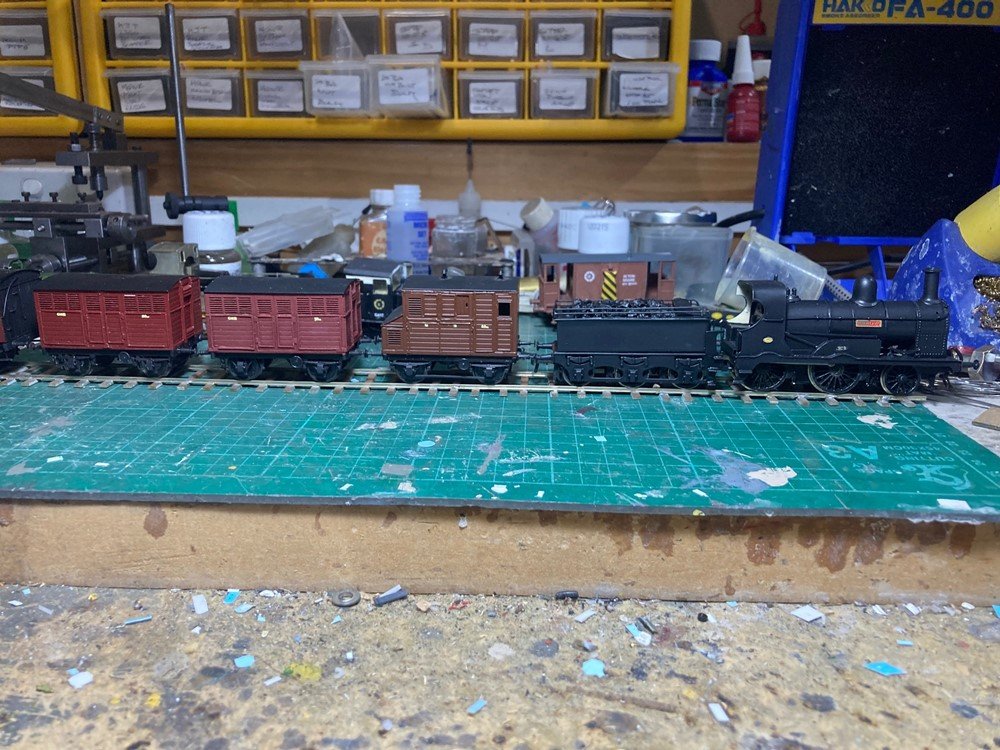

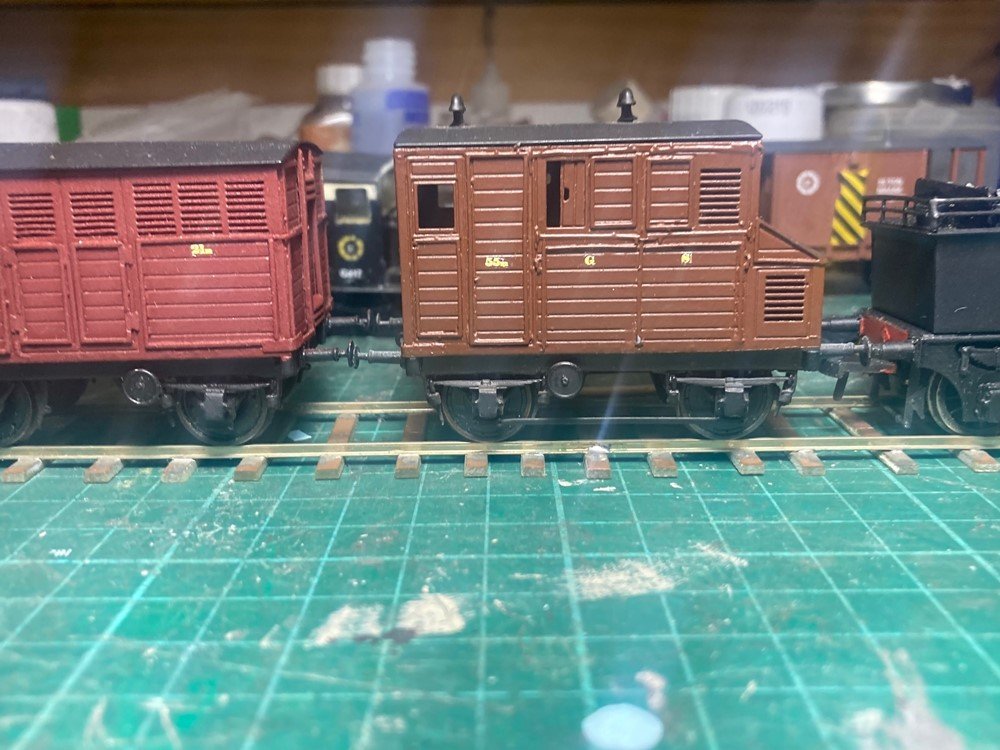



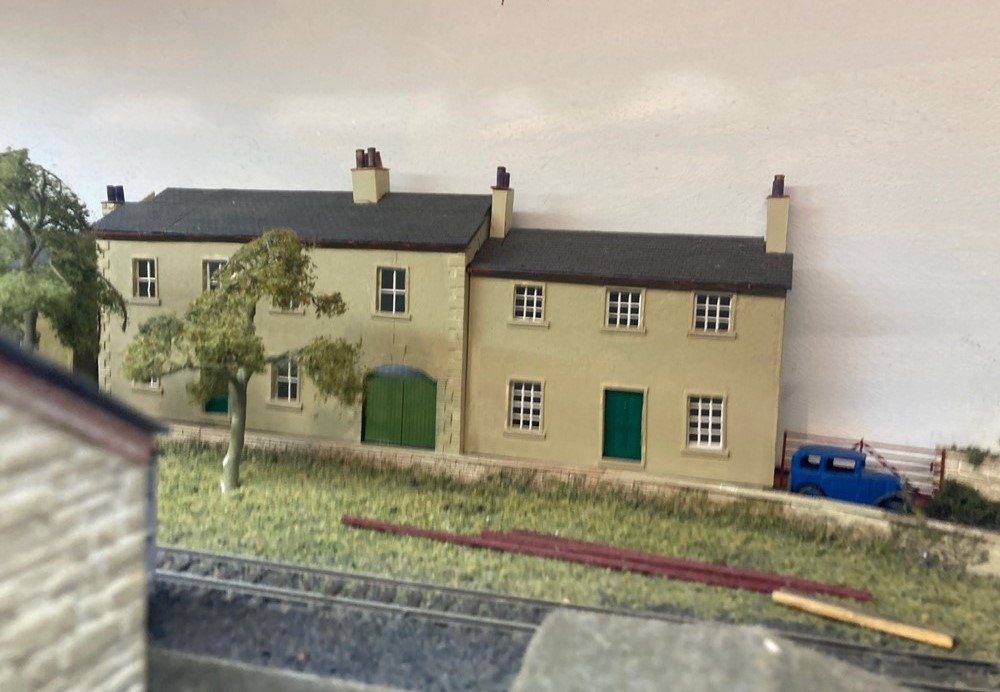
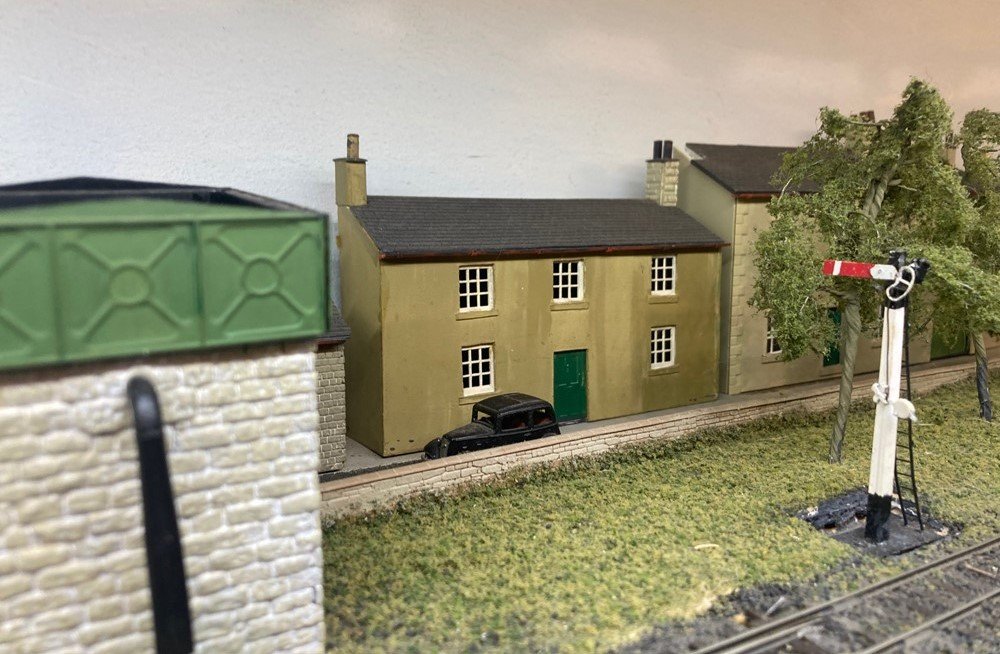
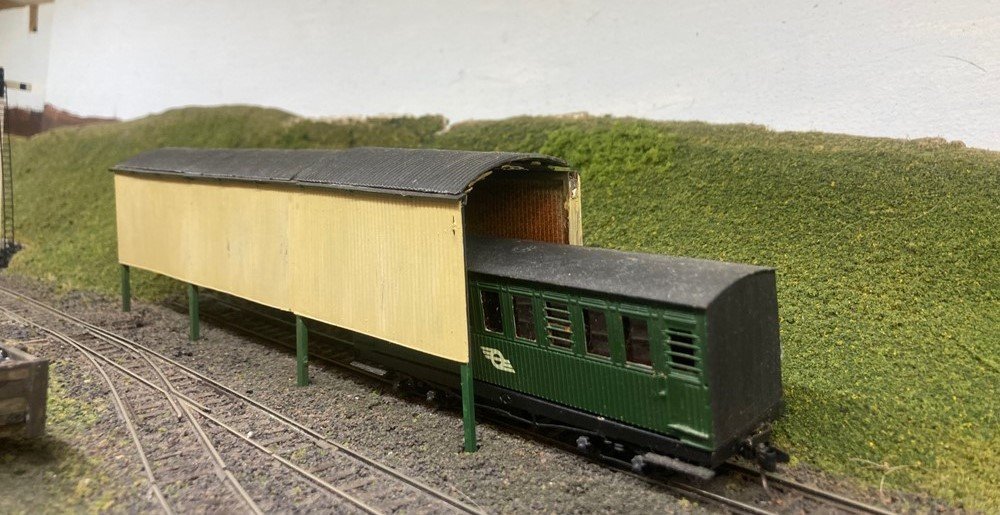
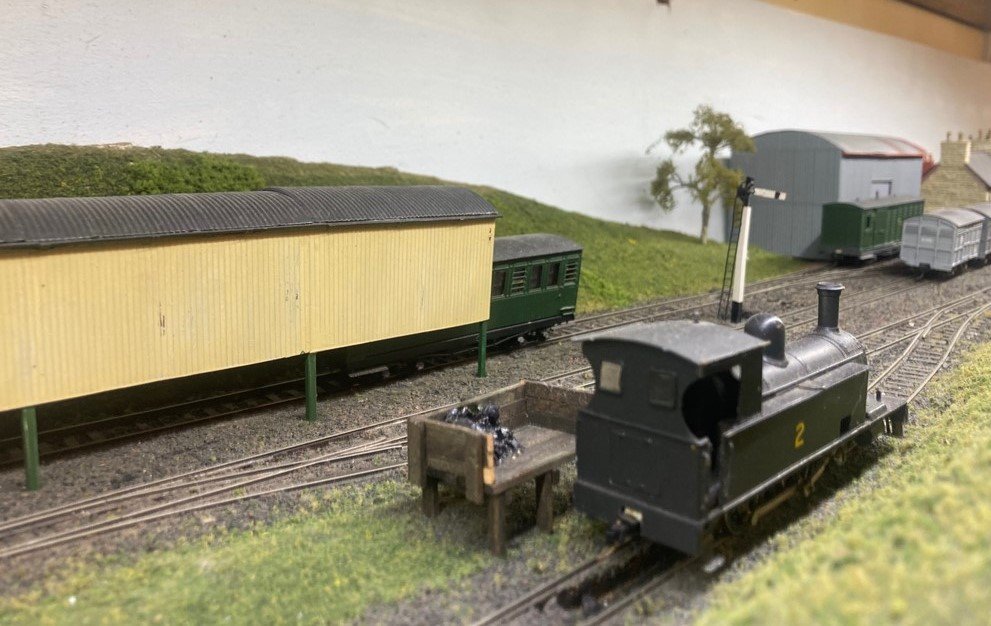
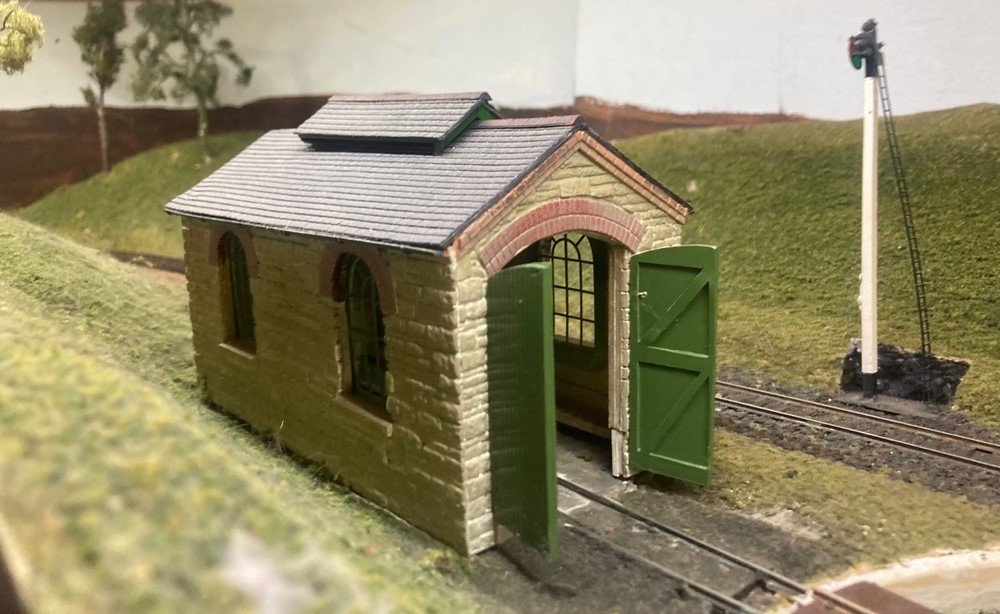
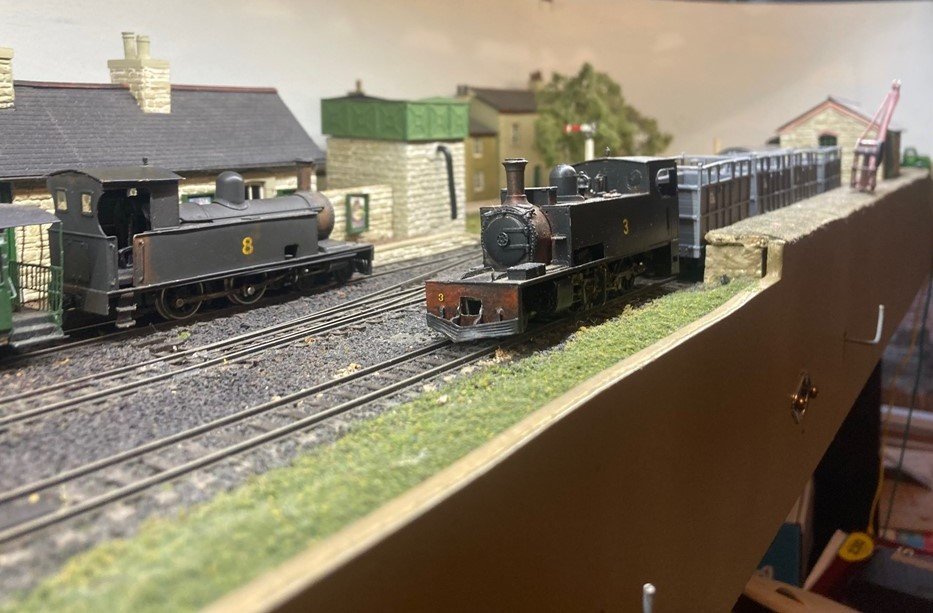
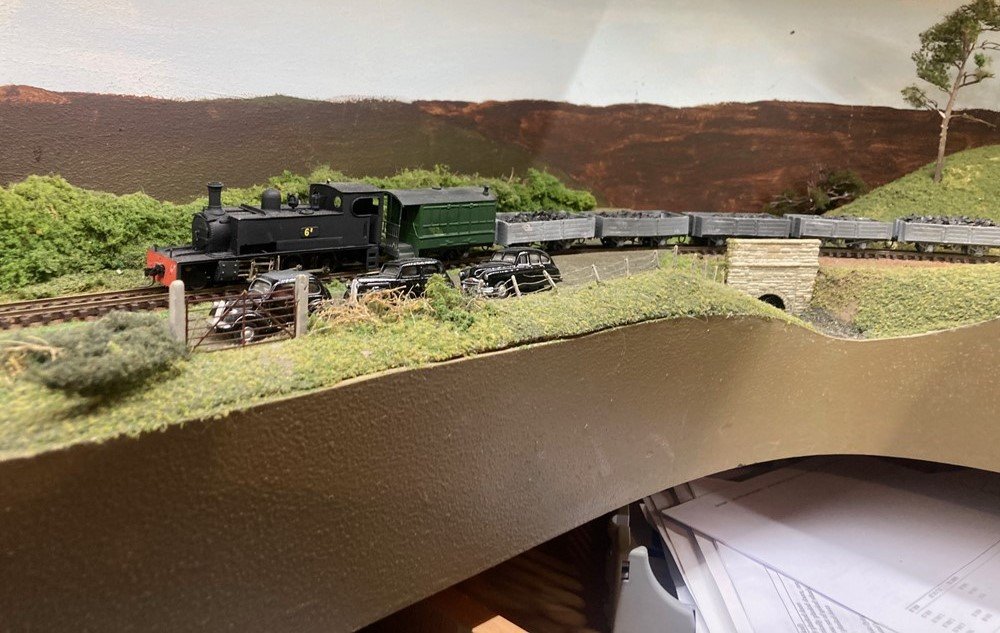

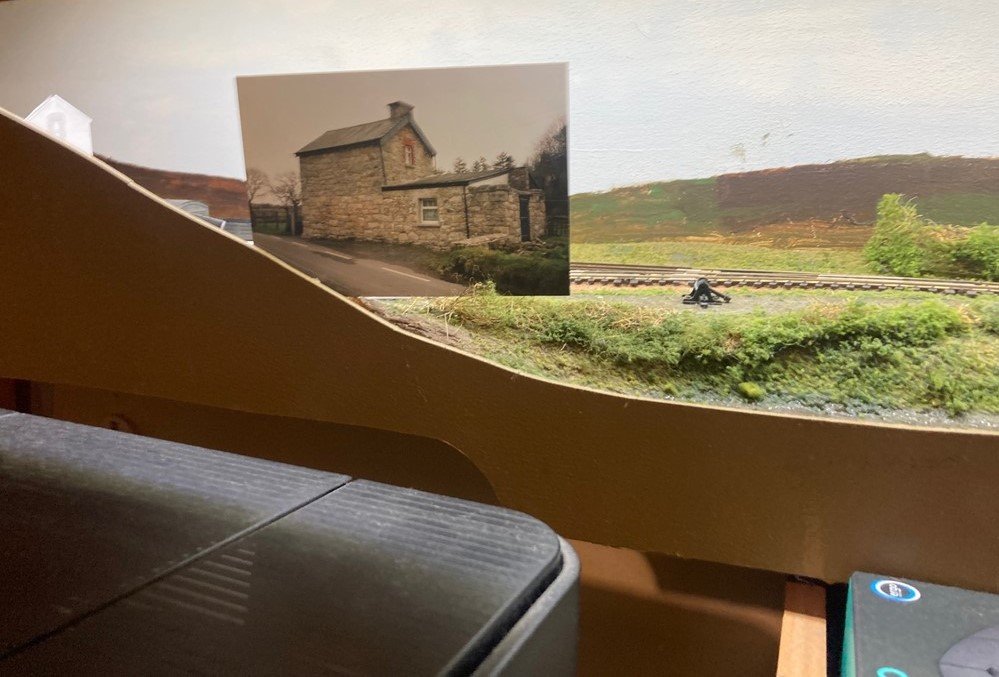
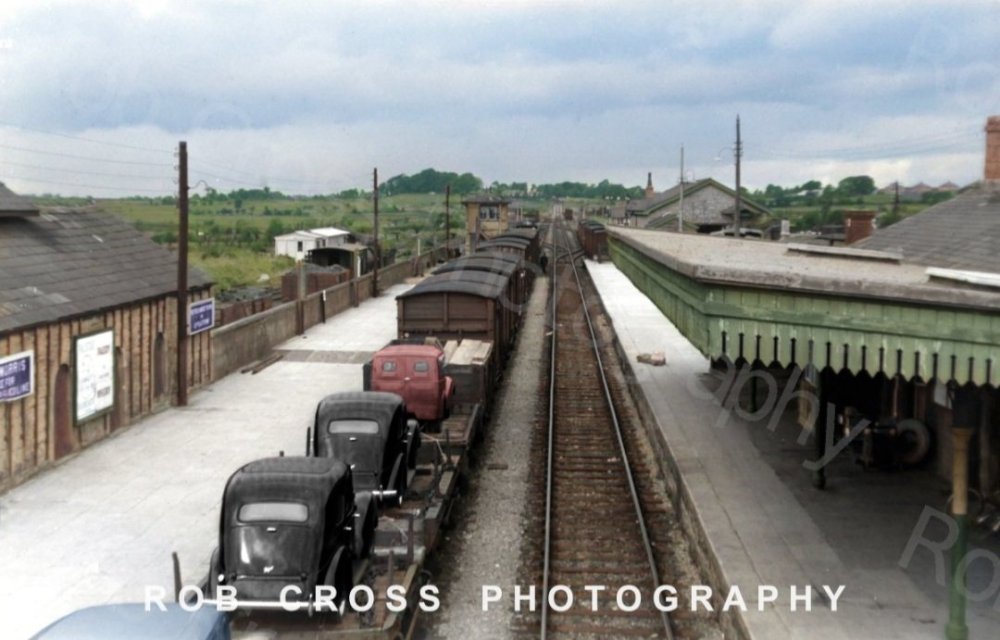

Alan's Workbench
in Workbench
Posted
Fair play Alan for forming the skirts where the chimney/dome sit on the smokebox/boiler, its something I haven't been able to get my head around physically using a lathe or in CAD work for 3D printing.
You appear to be able to build a loco from scratch than I can assemble a kit.
Interestingly I originally though the BCDR 0-6-4T was based on the "Large Leitrim Tank" design and did not realise it was a completely different design until I noticed the longer distance between the driving and trailing axle on your model than on the Leitrim (& South Australian) locos and realised the BCDR loco was not a "Long Boiler' type with the firebox placed behind the rear driving axle.